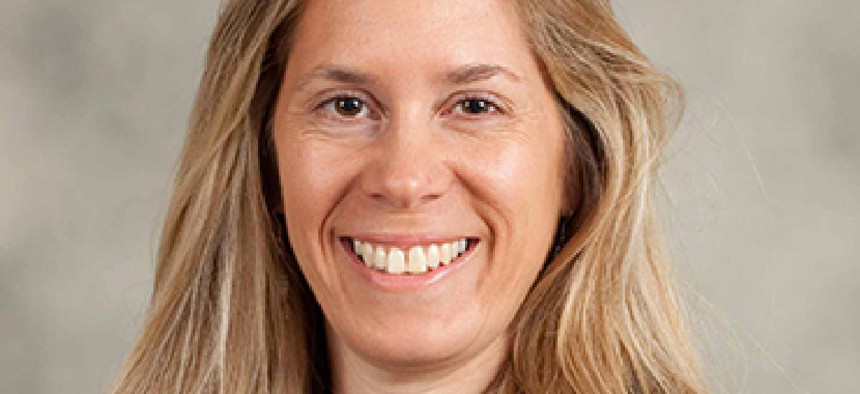Fight against redundant websites becomes a broader crusade

Sheila Campbell, who won a Federal 100 award in 2012 for her efforts to eliminate duplicative websites, has expanded her scope to encompass the larger federal digital strategy.

GSA's Sheila Campbell says the effort to consolidate websites has become a component of the larger digital government strategy.
Sometimes less really is more.
For years, the federal government has wrestled with the problem of redundant websites presenting information based on agency silos, not citizens' needs. A concerted effort to weed out unneeded ones is underway, however, and Sheila Campbell, the Director for the General Service Administration's Center for Excellence in Digital Government, has been in the thick of it. By providing federal agencies with guidelines, tools and best practices, she and her team have paved the way for the digital government strategy to become a reality.
Campbell was a recipient of a 2012 Federal 100 Award for her work in the government-wide effort to eliminate redundant and outdated federal websites (several hundred were shut down or combined), and she said in a recent interview that agencies have continued to streamline.
“I would say that there has been a lot of progress in this area, but what we’ve seen is that the effort to consolidate websites has really sort of rolled into and morphed into the larger digital government strategy, and so agencies are looking much broader than reforming their websites,” Campbell said.
“[It’s] a very good thing that websites aren’t viewed as a narrow focus in agencies, they’re viewed as part of a larger effort to reform how we manage our information digitally, so agencies are looking in a much more holistic way in terms of ‘how do we ensure that we are creating government content that can be accessed any place, any time, on any device?’” she said.
There is also a new emphasis on metrics, Campbell said, which allows GSA and other agencies to make smarter decisions now that the obvious website fixes and consolidations have been made. Those analytics provide a better picture of where there may be some overlap, and where there are opportunities for better collaboration.
“If we can see that there are 10 websites on a particular topic, we can see the traffic and get some better data in terms of where people are going; I think that will help us make more informed management decisions,” Campbell said. She also noted that some agencies have been collecting this data, but this would be the first time the GSA can look across agencies’ metrics and get a better sense of areas on which to focus.
Campbell “has an intense passion for the government to deliver an excellent experience to the public through web-based technology,” said Martha Dorris, Deputy Associate Administrator for GSA’s Office of Citizen Services. “She’s also very committed to providing the information and services in an efficient way. Both of those drivers have led her to her work and in helping other agencies to understand that over time, websites have been proliferated and in many cases they are not high quality, or there are so many of them that it doesn’t allow the public to find what they need or what they are looking for.”
Further consolidation remains a goal, but Campbell has shifted focus to other projects that will help agencies improve digital services and implement the digital government strategy. Last month was the digital strategy's six-month milestone, and GSA released best practices for how to create open structured content management systems. It has also helped agencies with guidelines and training in terms of how to develop APIs in order to make content more shareable.
“We think that it’s hugely transformational and foundational to actually doing a lot of the work around web improvement, to actually get better data so we can make more informed management decisions about which websites are performing well, and which ones are perhaps not performing so well. And so for the first time, this common metrics tool will give us a bird’s eye view, a holistic view of what’s happening in the federal web space,” Campbell said.
Campbell and her team are also focusing on the next big trends in digital, and making sure that government is as mobile-friendly as possible.
“Mobile is a huge, huge priority for agencies right now in the digital strategy,” Campbell said. These priorities range from making sure they have mobile devices for their employees to offering a mobile app development platform. Through these efforts, agencies are ensuring that as they develop new digital and web-based tools, they are taking mobile into consideration as part of the whole life-cycle, according to Campbell.
The GSA is also constantly working to build a cooperative approach to solve agencies’ digital roadblocks.
“We’ve built very strong networks and communities of practice, and this is where we find the biggest return on investment. By building out these networks we can really help agencies better implement and meet the milestones in the digital strategy,” Campbell said.
The GSA does this by leading the Federal Web Manager’s Council, and having robust communities of practice within social media, usability, accessibility and metrics. Campbell also nods to the successes of HowTo.gov and Digital Gov University, helping her to create a cooperative collaborative approach across agencies.
And then there's Campbell herself. She has been the voice of web and social media managers across the government, by understanding their challenges and providing resources and solutions to help them carry out their jobs, as Dorris sees it. And in a time of tight budgets and pressures to find economies of scale, Dorris said, Campbell represents a walking, talking shared service.
“It’s cost efficient because everyone can use [Campbell's resources and solutions] at once instead of every agency spending the same amount of money 25 times,” Dorris said.
NEXT STORY: Some cultural observations in Mexico


